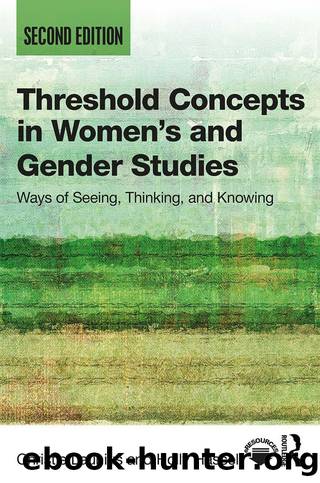Threshold Concepts in Women's and Gender Studies by Christie Launius Holly Hassel

Author:Christie Launius, Holly Hassel [Christie Launius, Holly Hassel]
Language: eng
Format: epub
Tags: Social Science, Sociology, General
ISBN: 9781351397223
Google: 0i1NDwAAQBAJ
Publisher: Routledge
Published: 2018-02-20T04:10:39+00:00
Case Study
The role of both institutions and ideology in maintaining systems of privilege and oppression can be seen through an examination of the bootstraps myth, which is the idea that upward class mobility is not only possible but probable, and that individual will and hard work are the only requisites for moving out of poverty and into the middle class. One of the consequences or implications of this myth is that poor people are then blamed for their continued poverty. Within the logic of the bootstraps myth, if individual will and hard work are the only requisites for moving out of poverty and into the middle class, then poverty can be explained by a lack of will and hard work on the part of poor people.
The ideology of upward class mobility has its roots in the long history of the United States as a colony, but was popularized by a series of novels in the 1890s written by Horatio Alger, novels about hardworking boys whose work elevated them from a hardscrabble life to one of success and luxury. So-called Cinderella or rags-to-riches stories continue to be popular and have been continually updated over the past century in such movies as Pretty Woman, Maid in Manhattan, The Blind Side, and Slumdog Millionaire. Rags-to-riches stories are also a frequent premise of reality television shows. These narratives have the effect of reinforcing belief in the possibility of dramatic upward mobility. This ideology is also buttressed by the language we use to talk (or avoid talking) about class in the United States. Politicians, for example, almost always use the term âmiddle-class Americansâ to refer to the broad mainstream and rarely use class labels that reflect the reality that a full majority of Americans are in fact working-class. The bootstraps myth has great explanatory and persuasive power because it builds upon a cultural belief in self-determination that resonates with many U.S. residents, the idea that we are each the captain of our own destiny, as it were.
However, data on the realities of social mobility demonstrate that, in fact, movement from one class to a higher or lower one, particularly from the lowest rungs of the American economic ladder to a higher one, is uncommon and diffi cult, as data from a New York Times special feature on social class reveal. In covering the topic of âHow Class Works,â the New York Times tracked American families by income quintile (breaking down family income by quintile) and examining how, over time, people in those income brackets moved up or down the âeconomic ladder.â
As these data illustrate, social class is fairly immutable; that is, the bottom fifth of the U.S. population in 1988 largely remained in that economic quintile, with relatively few people born into poverty rising up even a single income quintile. The same immutability is demonstrated for those in the top income quintile. In sum, the class a person is born into greatly shapes life experiences and has a huge impact over the life course. Gregory
Download
This site does not store any files on its server. We only index and link to content provided by other sites. Please contact the content providers to delete copyright contents if any and email us, we'll remove relevant links or contents immediately.
Chaco's Northern Prodigies : Salmon, Aztec, and the Ascendancy of the Middle San Juan Region after AD 1100 by Paul F. Reed(358)
Law Enforcement Interpersonal Communication and Conflict Management by Brian Douglas Fitch(349)
Digital International Relations by Unknown(348)
Skilled interpersonal communication: Research, theory and practice, Fifth edition by Owen Hargie(330)
Critical Perspectives on Human Security : Rethinking Emancipation and Power in International Relations by David Chandler; Nik Hynek(330)
The Enduring Color Line in U.S. Athletics by Krystal Beamon Chris M. Messer(327)
Evidence-Based Policy Making in Labor Economics by Hamermesh Daniel S.;Nottmeyer Olga K.;Nottmeyer Olga;King Sarah;King Sarah;King Sarah;(301)
EPSO CAST Political affairs EU policies: How to succeed in the selection procedure by Franco Reverte José María(298)
Writing Public Policy - A Practical Guide to Communicating in the Policy Making Process by Catherine F. Smith(278)
Criminological Theory in Context by John Martyn Chamberlain(272)
Tibeton Yoga Its Secret Doc by Evans-Wentz(270)
Threshold Concepts in Women's and Gender Studies by Christie Launius Holly Hassel(267)
Rothschild and Early Jewish Colonization in Palestine (Geographical Perspectives on the Human Past) by Ran Aaronsohn(266)
Social Problems, Social Issues, Social Science by James Wright(264)
Positive Psychology and Spirituality in Counselling and Psychotherapy (Conflict, Ethics, and Spirituality, 12) by unknow(263)
Play in child development and psychotherapy: toward empirically supported practice by Sandra W. Russ(256)
Cognitive Development in Infancy and Childhood (Elements in Child Development) by Mary Gauvain(255)
Latin American Politics and Society by Gerardo L. Munck & Juan Pablo Luna(224)
What Makes a Social Crisis?: The Societalization of Social Problems by Jeffrey C. Alexander(221)
